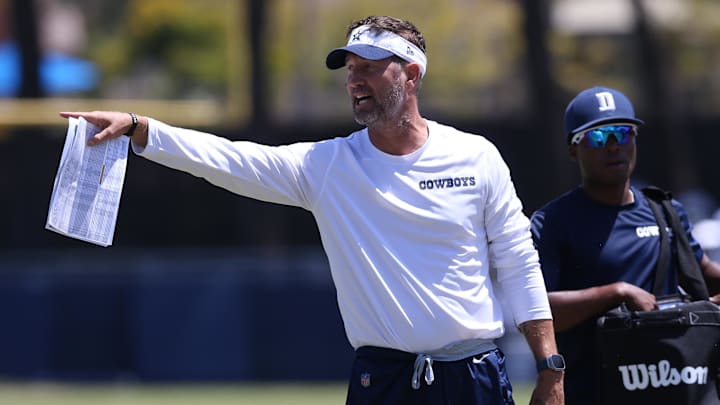The Dallas Cowboys’ hiring of Brian Schottenheimer as head coach has sparked fresh excitement and a dose of skepticism across the fanbase. Known for his energetic approach, Schottenheimer’s recent public comments have promised connection, accountability, and a strong emphasis on culture. As fans dissect every interview and quote, it’s worth examining whether this optimism holds up against the reality of the Cowboys’ roster and the upcoming season’s tough schedule.
“For them to share their stories with their teammates allows them when they’re out there on the field and they’re having a tough day and it’s hot and they’re pushing through a padded practice in Oxnard, they’re able to truly pull together and work together,” Coach Schottenheimer said. “I think that’s going to help us finish games, finish practices. When you have a tough moment, you have a tough stretch in the season, you work through those problems because they believe in one another and, more importantly, they love one another.”
Coach Schotty’s message through leadership and culture change
Schottenheimer steps into the position with over 25 years of NFL coaching experience, including stints as offensive coordinator for the Jets, Rams, Seahawks and Cowboys. His demeanor is described as authentic and people-focused. In his initial press conferences, Schottenheimer has stressed team building and shifting the culture. He’s made it clear that he won’t change who he is for the job. What you see is what you get.
It would be a disservice to just put out a few quotes from Schotty today. Fans I encourage you to listen to the whole thing. He is approaching this thing w the energy and spirit of a college coach. Really digging into his players and the culture. Again will it translate to wins?…
— Jane Slater (@SlaterNFL) May 20, 2025
His philosophy centers on connection and accountability, starting from the top. Small changes such as locker assignments to mix things up a bit among players at different levels, signal his commitment to team chemistry. There’s a new energy in the building, meant to foster leadership and accountability.
Consistency and Connection at the root of Schottenheimer’s comments
Schottenheimer’s comments focus on creating “family” in the locker room as an environment built on honest communication and respect. He’s challenged Cowboys players to be more than just a collection of talent. Focus on discipline and mutual accountability reflects a shift in culture already.
He keeps his expectations clear. By consistently checking in with players, keeping meetings interactive and making space for veterans to guide younger players, coach Schotty has set the groundwork for a more stable environment. A focus on consistency and accountability is much different than the sometimes chaotic Cowboys culture of the past. However, it is still early in the process so it’ll be interesting to see how this new message holds up as we approach and get deep into the 2025 campaign.
Success rate of first-year Cowboys head coaches
How do Cowboys head coaches fare in their first season? Multiple head coaches in Dallas have made the postseason in year one. Jason Garrett (2010), Wade Phillips (2007), Bill Parcells (2003) and Barry Switzer (1994) all led the franchise to a playoff appearance in their first season. More recently, Mike McCarthy (2020) finished outside the postseason in his debut. Even all-time greats like Jimmy Johnson (1989) and Tom Landry (1960) failed to reach the playoffs.
Tangible improvements are what move the needle
Schottenheimer takes over a roster with established stars but with plenty of holes, especially on defense. Historically, success has hinged on either a top-10 offense or major upgrades on defense, neither of which is guaranteed in 2025.
Defensively, the struggles are hard to ignore. Opponents averaged 27.5 points per game (31st in NFL) and 355 yards per game (28th in NFL). The team managed 52 sacks (3rd in NFL) and 13 interceptions, but weaknesses against the run and inconsistent secondary play dragged down the unit’s overall rankings.
Knowing this, despite all the positives in May, fans should be cautiously optimistic. Schottenheimer’s philosophy promises more consistency and cohesion, but recency bias demands patience and tangible improvement. If the team responds to Schottenheimer’s leadership and fixes glaring weaknesses, excitement is justified, but only time and results will prove if this culture shift is real or a temporary bout of lip service.
